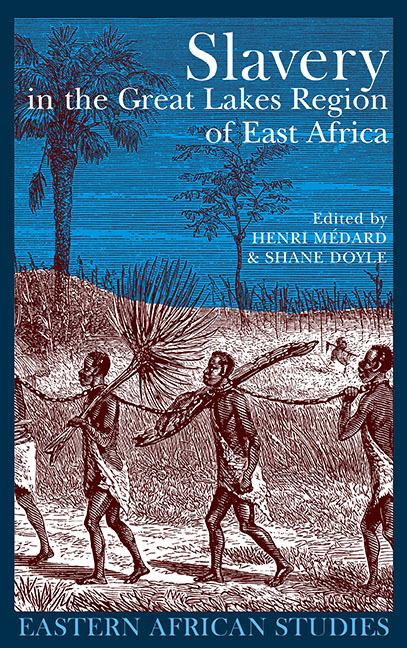Book contents
- Frontmatter
- Dedication
- Contents
- List of Maps & Tables
- Notes on Contributors
- Introduction
- 1 Violence, Marginality, Scorn & Honour: Language evidence of slavery to the eighteenth century
- 2 Notes on the Rise of Slavery & Social Change in Unyamwezi c. 1860 –1900
- 3 Slavery & Forced Labour in the Eastern Congo 1850 –1910
- 4 Legacies of Slavery in North West Uganda: The story of the ‘One-Elevens’
- 5 Human Booty in Buganda: Some observations on the seizure of people in war c.1700 –1890
- 6 Stolen People & Autonomous Chiefs in Nineteenth-Century Buganda: The social consequences of non-free followers
- 7 Women's Experiences of Enslavement & Slavery in Late Nineteenth- & Early Twentieth-Century Uganda
- 8 Slavery & Other Forms of Social Oppression in Ankole 1890 –1940
- 9 The Slave Trade in Burundi & Rwanda at the Beginning of German Colonisation 1890 –1906
- 10 Bunyoro & the Demography of Slavery Debate: Fertility, kinship & assimilation
- References
- Index
2 - Notes on the Rise of Slavery & Social Change in Unyamwezi c. 1860 –1900
Published online by Cambridge University Press: 11 August 2017
- Frontmatter
- Dedication
- Contents
- List of Maps & Tables
- Notes on Contributors
- Introduction
- 1 Violence, Marginality, Scorn & Honour: Language evidence of slavery to the eighteenth century
- 2 Notes on the Rise of Slavery & Social Change in Unyamwezi c. 1860 –1900
- 3 Slavery & Forced Labour in the Eastern Congo 1850 –1910
- 4 Legacies of Slavery in North West Uganda: The story of the ‘One-Elevens’
- 5 Human Booty in Buganda: Some observations on the seizure of people in war c.1700 –1890
- 6 Stolen People & Autonomous Chiefs in Nineteenth-Century Buganda: The social consequences of non-free followers
- 7 Women's Experiences of Enslavement & Slavery in Late Nineteenth- & Early Twentieth-Century Uganda
- 8 Slavery & Other Forms of Social Oppression in Ankole 1890 –1940
- 9 The Slave Trade in Burundi & Rwanda at the Beginning of German Colonisation 1890 –1906
- 10 Bunyoro & the Demography of Slavery Debate: Fertility, kinship & assimilation
- References
- Index
Summary
Introduction
When German explorers and colonial officials arrived in Unyamwezi in the 1880s and 1890s, they recorded the presence of very large numbers of slaves residing in the area. Based on his visits to the town of Tabora in the mid-1880s, the traveller Reichard noted that about 75 per cent of the population in Unyamwezi were slaves. The first person who actually calculated their total number was Hauptmann Puder, one of the earliest permanent administrative officers in Tabora district. Without giving an indication of whom he considered to be a slave or how he arrived at this particular estimate, he stated in an official report in 1890 that about twothirds of Tabora district's total population of around 350,000, i.e. approximately 233,000 people, were locally regarded as slaves. Both Reichard's and Puder's figures are likely to be on the high side, but, even allowing for a wide margin of error, the numbers are still impressive, especially as they seem to have risen to that high level in a comparatively short period of time, probably in less than forty years.
This essay endeavours to provide an historical account of the rise of slavery in Unyamwezi in the second half of the nineteenth century. It will be argued that this expansion is best understood as a dynamic social process, which altered Unyamwezi society as a whole. This requires us to show that, in the relevant period, the local economy (the forms of wealth production, especially the organisation of labour), social relationships (the means of acquiring status and honour, particularly local gender and kinship relations), and the political order (the forms of exercising chiefl power, both within local society and with regard to neighbouring polities), underwent significant and large-scale change.
Slavery in Nineteenth-century Tanganyika
The social history of slavery and the slave trade in Tanganyika in the nineteenth century evolved around the interaction, tensions and contradictions of the social relations that defined personhood within a community (as insiders), and the commercial transactions that actually or potentially reduced people to mere objects of exchange and exploitation (as outsiders). It was within these social extremes, which seem to represent opposing configurations of social relations, that slaves had to make their living.
- Type
- Chapter
- Information
- Slavery in the Great Lakes Region of East Africa , pp. 76 - 110Publisher: Boydell & BrewerPrint publication year: 2007



